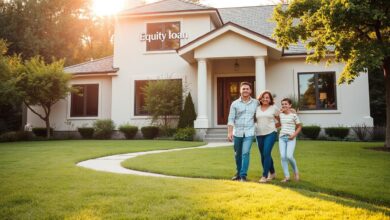Bad Credit Loans: Find Financing Options Now
Did you know nearly one-third of Americans have a credit score below 600? This makes it hard to get loans for bad credit.
Many people struggle to get financial help because of their credit history. But, there are loans for those with bad credit. We know a low credit score doesn’t mean you’re not trustworthy.
Life’s surprises can hurt your credit score. But, that shouldn’t stop you from getting the financial help you need. Bad credit loans are for those times, helping you get funds when you need them most.
Key Takeaways
- Bad credit loans are available for individuals with poor credit scores.
- Some lenders specialize in offering loans to those with bad credit.
- Having bad credit doesn’t mean you’re ineligible for financing.
- Life events can impact your credit score, but financing options are available.
- Bad credit loans can provide necessary financial assistance.
Understanding Loans for Bad Credit
Getting a loan with bad credit means knowing your options well. We’ll dive into what bad credit is and how it impacts your loan chances.
What Defines Bad Credit?
A bad credit score falls between 300 and 579. This shows a history of credit problems, like late payments or high debt. Lenders see borrowers with bad credit as riskier, which can limit their loan access or lead to worse terms.
Knowing how bad credit affects your loan chances is key. Lenders use credit scores to guess if you’ll pay back the loan. A score under 580 makes it hard to get traditional loans.
Common Misconceptions About Bad Credit
Many think bad credit means no loan options. But, this isn’t always true. There are lenders that offer bad credit loans, helping those with poor credit history.
- Some common misconceptions include the belief that bad credit loans are always predatory or that they’re only for emergency situations.
- In reality, bad credit loans can be used for various purposes, such as consolidating debt or financing a significant purchase.
- It’s also worth noting that some lenders offer more favorable terms than others, so it’s crucial to shop around.
By understanding these misconceptions and knowing what to look for, we can make more informed decisions when seeking a loan with bad credit.
The Importance of Credit Scores
Credit scores are very important, mainly when we need loans with good terms. They play a big role in deciding if we can get a loan and what interest rates we’ll get.
Knowing how credit scores work and keeping a good score can help a lot. It makes it easier to get poor credit loans with better terms.
How Credit Scores Affect Loan Eligibility
Credit scores show lenders how reliable we are financially. A high score means we’re less risky, so we’re more likely to get loans.
But, a low score can make it hard to get loans. It might also mean we have to pay higher interest rates.
Types of Credit Scores
There are different credit scores, like FICO and VantageScores. FICO scores go from 300 to 850, with higher numbers being better.
VantageScores also go from 300 to 850. They aim to be the same across all major credit bureaus.
Knowing the differences between these scores helps us make smarter financial choices.
Types of Loans Available for Bad Credit
Having bad credit doesn’t mean you can’t get a loan. There are many options available. These include personal loans, payday loans, and title loans. Each has its own features and needs.
Personal Loans
Personal loans can help with many needs, like paying off debt or buying something big. They usually don’t require collateral. Some lenders offer no credit check loans for those with bad credit. But, these might have higher interest rates or fees.
Payday Loans
Payday loans are short-term and due on your next payday. They’re for quick cash in emergencies. But, they often have high interest rates and fees. Always check the terms before agreeing.
Title Loans
Title loans use your vehicle title as collateral. They offer more money than payday loans and might have better rates. But, not paying back can mean losing your car. Think carefully before getting a title loan.
It’s important to know the good and bad of each loan. Always read the fine print before you decide.
How to Qualify for Bad Credit Loans
We can help you understand how to qualify for a bad credit loan. You’ll need to meet certain criteria and provide the right documents.
Eligibility Requirements
Lenders look at several things when deciding if you qualify for quick loans for bad credit. These include:
- Income level and stability
- Employment history
- Other financial obligations
- Bank account details
Having a steady income and a good debt-to-income ratio helps a lot. Some lenders might also look at your history with installment loans for bad credit.
Documentation Needed
To apply for a bad credit loan, you’ll need to provide:
- Identification proof (driver’s license or passport)
- Proof of income (pay stubs or bank statements)
- Proof of residence (utility bills or lease agreement)
- Bank account information
Having all your documents ready makes the application process easier. It’s wise to check with the lender for any special requirements they might have.
Knowing what you need to qualify and having your documents ready can boost your chances. Whether it’s quick loans for bad credit or installment loans for bad credit, being prepared is crucial.
Pros and Cons of Bad Credit Loans
Bad credit loans offer financing but also have risks. It’s important to know both sides to make a smart choice.
Advantages of Bad Credit Loans
Bad credit loans give you access to money when others won’t. They help people with poor credit scores deal with urgent money needs. This can include unexpected bills or paying off debts.
Also, paying back these loans can boost your credit score. Lenders report payments to credit agencies. Regular, on-time payments can improve your score.
Potential Drawbacks
Bad credit loans often have higher interest rates and fees than regular loans. This is because lenders see borrowers with bad credit as riskier. They charge more to protect themselves.
Experts warn about predatory lending that can make money problems worse. Always check the loan terms carefully to avoid bad deals.
“The key to benefiting from bad credit loans is to use them responsibly and make timely repayments.”
In summary, bad credit loans can help, but be aware of the downsides. Manage the loan well to avoid more financial trouble.
Finding Reputable Lenders
Finding a good lender is key when you need a bad credit loan. It can feel overwhelming to look through all the options. But, it’s important to find a loan that fits your financial needs.

What to Look for in a Lender
Transparency is important when choosing a lender. Look for lenders that clearly state their interest rates, fees, and repayment terms. This way, you know the loan’s total cost and avoid surprises.
Also, check the lender’s reputation. Reading customer reviews and ratings can tell you a lot about their reliability and service quality.
Trusted Lenders in the Industry
There are many lenders that focus on bad credit loans. They offer different products for various financial needs. You might find lenders with flexible repayment options and competitive interest rates.
It’s good to see if the lender is accredited or has positive reviews from trusted sources. This shows they follow ethical lending practices.
By doing your homework and comparing lenders, you can choose wisely. This choice will help you reach your financial goals and manage your debt well.
Comparing Loan Offers
There are many loan options out there. It’s important to compare them to find the best one. This way, we can choose a loan that fits our financial needs.
Key Factors to Consider
When looking at loan offers, there are a few key factors to keep in mind. These include:
- Interest rates
- Repayment terms
- Fees associated with the loan
- Loan amount and flexibility
By looking at these, we can pick a loan that meets our financial goals.
Interest Rates and Terms
Interest rates and terms are key parts of a loan. A lower interest rate can save you money. Also, terms that let you pay back the loan over a longer time can make monthly payments easier.
But, a longer term might mean paying more in interest over time. A shorter term might have higher monthly payments. Yet, it can save you money on interest in the long run.
“The key to saving money on a loan is to carefully review the interest rate and terms. By doing so, borrowers can make informed decisions that align with their financial goals.”
To make a smart choice, compare the interest rates and terms from different lenders. This helps us find the loan that’s right for us.
Preparing to Apply for a Loan
Understanding how to apply for a bad credit loan is key to success. It’s important to take steps to make yourself a better candidate. This way, you can improve your chances of getting approved.
Improving Credit Before Applying
Boosting your credit score before applying can help a lot. Here are some tips to consider:
- Paying down debt to reduce your debt-to-income ratio
- Disputing errors on your credit report to ensure its accuracy
- Avoiding new credit inquiries to prevent further negatively impacting your score
By working on these areas, you can make your credit score better. This makes you more appealing to lenders.
Crafting a Solid Loan Application
A good loan application is essential for approval. To make a strong application, remember to:
- Provide accurate and complete information about your financial situation
- Include all required documentation, such as proof of income and identification
- Clearly outline your loan requirements and proposed repayment plan
With a detailed and well-organized application, you show you’re a responsible borrower. This can increase your approval chances.

By following these steps, we can better our chances of getting a bad credit loan. It’s all about being proactive and showing we’re good candidates.
Tips for Managing Bad Credit Loans
Managing bad credit loans needs a smart plan for paying back and talking to lenders. We know it’s key to get your finances back on track and boost your credit score. This will help you over time.
Let’s look at some good ways to pay back your loan. A solid plan can really help you manage your loan better. Here are some important points to think about:
Repayment Strategies
- Prioritize Timely Payments: Paying on time is very important. Late payments can hurt your credit score, but on-time payments can help it.
- Pay More Than the Minimum: If you can, paying more than the minimum helps pay off the loan faster. This means you’ll pay less interest in the long run.
- Consider Refinancing: If interest rates have gone down or your credit score has improved, refinancing might give you better terms. This could mean lower monthly payments.
It’s also crucial to keep a good relationship with your lender. Being open and honest can help avoid problems. It also helps find solutions if you’re having trouble paying back.
Maintaining Communication with Lenders
If you’re struggling to make payments, contact your lender right away. Many lenders want to help find a way to make payments work. For tips on improving your credit score and managing loans, check out Experian’s guide on fixing bad credit.
By using these strategies, you can manage your bad credit loan well. This will help you move towards a better financial future.
Legal Protections and Consumer Rights
In the world of bad credit loans, knowing your rights is key. Understanding these protections can greatly affect your financial health.
When you borrow with bad credit, you have certain rights. These include the right to clear loan information, protection from unfair lending, and the chance to correct credit report errors.
Understanding Your Rights
It’s crucial to know what these rights mean. For example, the Truth in Lending Act (TILA) makes sure lenders share loan details clearly. This includes the APR, fees, and how you’ll pay back the loan. This helps you make smart choices about your loans.
“Consumers have the right to be informed about the terms and conditions of their loans. Lenders must provide clear and accurate information to help borrowers make informed decisions.”
The Fair Credit Reporting Act (FCRA) also plays a big role. It controls how credit info is gathered and shared. With FCRA, you can challenge any wrong info on your credit report. This keeps your credit score fair.
| Protection | Description | Benefit to Consumers |
|---|---|---|
| Truth in Lending Act (TILA) | Requires lenders to provide clear loan terms | Informed decision-making |
| Fair Credit Reporting Act (FCRA) | Regulates credit information collection and use | Accurate credit reporting |
Reporting Issues to Authorities
If you face problems with your lender, like unfair practices or hidden loan details, you should report it. You can file a complaint with the Consumer Financial Protection Bureau (CFPB) or your state’s Attorney General’s office.
When you report a problem, having proof is important. This includes loan agreements, messages, and any other important documents. This proof helps support your complaint and can help fix the issue.
By knowing your rights and how to report problems, you can handle bad credit loans better. This protects your financial well-being.
Resources for Bad Credit Borrowers
Dealing with bad credit can feel overwhelming. But, there are many resources to help borrowers find their way.
Guidance from Credit Experts
Credit counseling services offer great advice on managing debt and boosting credit scores. They help people understand their financial health and plan for improvement. Working with credit counselors can give a clearer view of one’s financial situation.
Simplifying Loan Comparisons
Online platforms for loan comparison are also very helpful. They let borrowers see different loan offers side by side. This makes it easier to find the right bad credit loan.
Using credit counseling and online loan comparison tools can help manage finances better. It’s a step towards improving credit scores.









